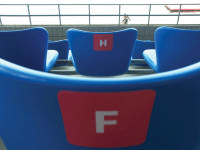
The point, for a true Zen spectator, is to embrace and experience his or her role in the event at hand. You have the competitors, (the main players in this play, needlesstosay), you have the officials, the coaches on bikes pedaling along the side of the course, the press people, the security people (hundreds upon hundreds - someone should check their DNA - human cloning is suspected); you have the photogs scurrying about looking for a sell-able shot. (What amazing good luck to find Prince Albert of Monaco in the grandstand, here to watch his compatriot compete in the men's 1X. And what bad luck to be sitting just in front of the Prince, suddenly feeling like you're on the wrong end of a cannon, all these monster lenses pointed in your direction. I don't think you're going to be seeing the Prince walking through Costco anytime soon grabbing an extra sample of beef jerky off the tray. You can't help but feel bad for the guy. There's a not-too-distant Olympic rowing connection - his mother being Princess Grace, whose father was John B. Kelly, who won two gold medals in the 2X ('20 and '24) and a gold in the 1X in '20. Having seen photos of Kelly and now having seen the Prince in person, I can only conclude that the rowing-gene was not passed down. Just as well - he has a country to look after.)
These early days at the Olympic regatta make for excellent spectating since the races come fast and furious, one after the other, race #31 nipping at the heels of race #30. And the conditions were excellent. What a difference a day makes. Smooth water. Not too hot. Pretty much perfect rowing conditions.
While Zen spectating, one could not help but look on with knowing condescension at the troop of professional spectators who were hired to sit in the grandstands just across from the finish line tower. They yelled - they screamed - they stomped, clapped, sang, shouted - as though a blood relative was racing in every event. The reason- TV coverage hates an empty grandstand worse than nature abhors a vacuum. But these pro-spectators are never going to achieve enlightenment - at least not at the rowing course.
Race #52 was particularly good - the last of four quarterfinals for the men's 1X, with the top three finishers in each quarterfinal advancing to the semi-finals.
The world's best , Mahe Drysdale, was in this quarterfinal, along with a good Swedish sculler, Lassi Karonen, a good sculler from the Netherlands, Sjoerd Hamburger, a good sculler from Argentina, Santiago Fernandez, (4th at the 2004 Olympics,) and Ken Jurkowski of the US.
5 good scullers - three to advance. Anyone who has watched the excellent documentary The Perfect Stroke couldn't help but root for Sjoerd Hamburger, who was featured in the movie. (I think JL Racing has this documentary in stock - amazingly well photographed.)
Hamburger jumped out to the lead - came through the 500 in 1:39.39 - moving right along. Ken was in 4th. At the 1000, Hamburger was still in first and Ken was still in 4th. At the same 1500 meters - still in 4th - Ken cranked off a 1:40.40 (his fastest 500 of the race) to move into 3rd place and into the semi-finals.
That was a good effort.